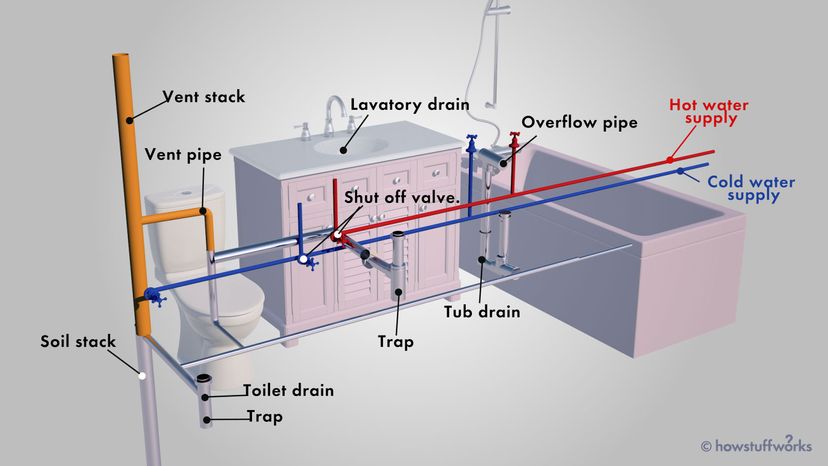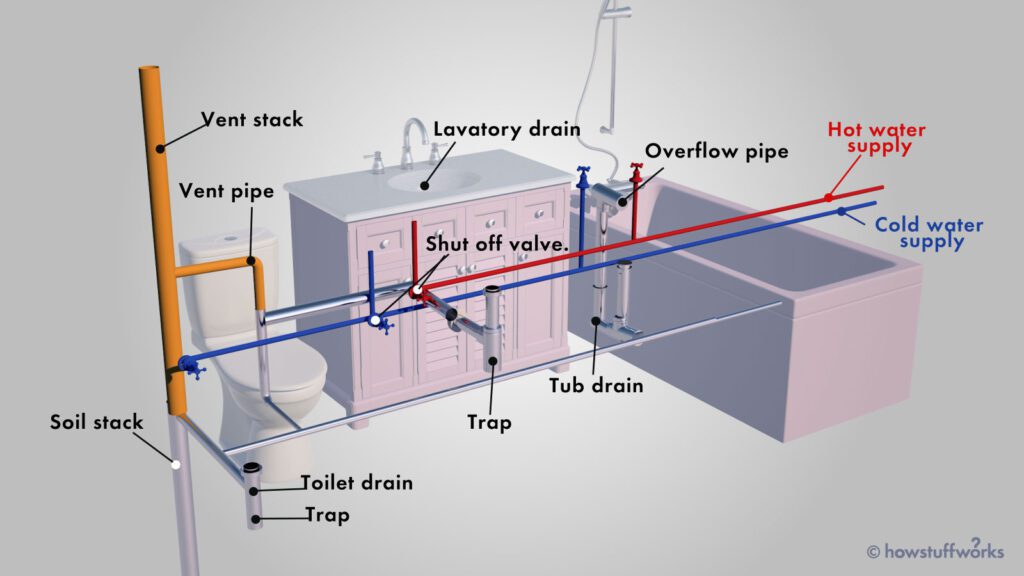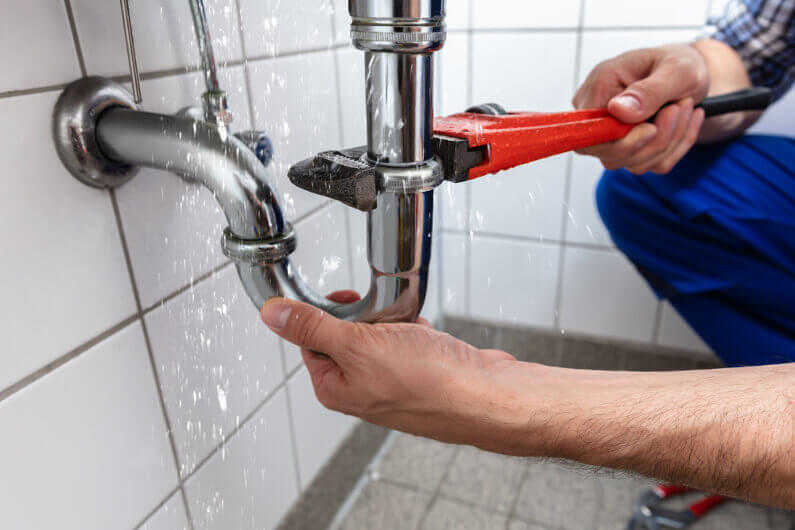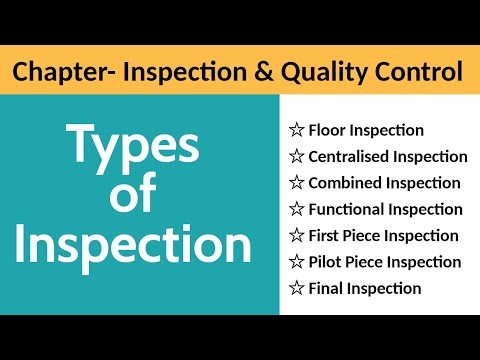In this article, you will discover the key components that make up a plumbing system. From pipes to fixtures, understanding these five essential elements will provide you with a solid foundation of knowledge when it comes to plumbing. So, let’s explore the inner workings of this essential system and uncover how everything fits together seamlessly to keep your water flowing smoothly. The plumbing system consists of several key components that work together to ensure the proper supply and drainage of water in your home. Understanding these components is essential for maintaining and troubleshooting your plumbing system. In this article, we will explore the five main components of the plumbing system and discuss their role in keeping your water supply and drainage functioning smoothly.


Water Supply System
The water supply system is responsible for bringing clean and safe water into your home. It comprises various components that play a crucial role in delivering water to different fixtures.
Water Source
The water source is the starting point of the water supply system. It can be either a public water supply or a private well. Public water supply systems connect to your home through a meter, while private wells draw water from underground sources.
Water Meter
The water meter measures the volume of water consumed in your household. It enables you to monitor your water usage and ensures accuracy in billing. Water meters are typically located near the property line or within a utility room.
Main Shut-Off Valve
The main shut-off valve is a vital component that controls the flow of water into your entire home. In case of emergencies, such as a burst pipe or a major leak, shutting off the main valve is crucial to prevent further damage. It is usually located near the water meter or where the water supply enters your property.
Pressure Regulator
Water pressure regulators are devices that maintain a consistent and safe water pressure in your home. They reduce high water pressure to a desirable level, preventing potential damage to your plumbing fixtures and pipes. Pressure regulators are typically installed near the main shut-off valve.
Pipes and Fittings
Pipes and fittings are the backbone of the water supply system. They carry water from the source to various fixtures in your home. Commonly used types of pipes include copper, PVC, PEX, and galvanized steel pipes. Fittings, such as elbows, tees, reducers, couplings, and valves, ensure proper connections and allow for adjustments in the water flow.
Drainage System
The drainage system is responsible for removing wastewater from your home and ensuring proper sanitation. It consists of various components that play a crucial role in directing wastewater to the appropriate disposal point.
Sink Drain
The sink drain is an essential component that carries wastewater from your kitchen or bathroom sinks to the main drainpipe. It is usually equipped with a trap, which prevents sewer gases from entering your living space.
Toilet Drain
The toilet drain is specifically designed to handle human waste and toilet paper. It connects the toilet fixture to the main drainpipe, allowing for safe disposal of wastewater.
Shower Drain
The shower drain is responsible for removing wastewater from your shower or bathtub. It is designed to catch hair, soap residue, and other debris, preventing clogs in the drainpipe.
Bathtub Drain
Similar to the shower drain, the bathtub drain removes wastewater from your bathtub. It is typically larger in diameter to accommodate the increased water flow.
Floor Drain
Floor drains are commonly found in basements, laundry rooms, and garages. They prevent flooding by draining water that may accumulate on the floor. Floor drains are equipped with grates or covers to prevent debris from entering the drainpipe.


Fixtures
Plumbing fixtures are devices that utilize water within your home for various purposes. They are interconnected with the water supply and drainage systems, providing convenient access to water when needed.
Toilets
Toilets are essential fixtures in any household, providing a sanitary means for disposing of human waste. They are connected to the water supply and drainage systems, allowing for efficient flushing and waste removal.
Sinks
Sinks are common fixtures found in kitchens, bathrooms, and laundry rooms. They are used for activities such as washing dishes, hands, and clothes. Sinks come in various types and designs, including undermount, drop-in, and wall-mounted options.
Bathtubs
Bathtubs provide a means for relaxation and personal hygiene. They are essential fixtures in bathrooms, allowing for leisurely baths or quick showers. Bathtubs come in different sizes, shapes, and materials, catering to personal preferences and bathroom layouts.
Showers
Showers provide a convenient and efficient way to cleanse the body. They are available in a range of designs, including walk-in showers, enclosed shower stalls, and shower-tub combinations. Showers utilize a combination of water supply and drainage systems to ensure effective water flow and waste removal.
Bidets
Bidets are fixtures commonly found in bathrooms, providing an alternative means for personal hygiene. They are used for cleaning the genital and anal areas. Bidets are interconnected with the water supply and drainage systems, allowing for efficient water usage and waste disposal.
Vents
Vents are an integral part of the plumbing system, ensuring proper air circulation and preventing unpleasant odors, vacuum, or siphoning in the drainage system.
Vent Stacks
Vent stacks are vertical pipes that extend from the drainage system to the roof. They allow for the release of sewer gases and help maintain equalized pressure in the drainage system. Vent stacks also provide a pathway for air to enter the system, facilitating proper wastewater flow.
Air Admittance Valves (AAVs)
AAVs are mechanical devices that act as one-way vents. They allow air to enter the drainage system while preventing the escape of sewer gases. AAVs are often used in situations where traditional venting methods are impractical.
Vent Pipes
Vent pipes are additional pipes connected to the drainage system that provide extra ventilation. They improve airflow within the system, preventing water traps from being siphoned and maintaining optimal drainage.
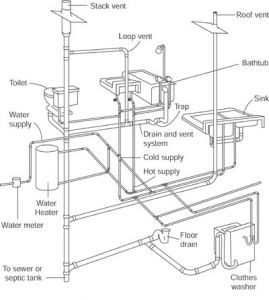

Traps
Traps are essential components of the plumbing system that prevent sewer gases from entering your living space. They create a water seal that prevents odors and harmful gases from traveling up through the drainpipe.
P-Traps
P-traps are the most common type of traps used in plumbing systems. They are shaped like the letter “P” and are often found under sinks and other fixtures. P-traps hold a small amount of water, creating a water seal that acts as a barrier against sewer gases.
S-Traps
S-traps, as the name suggests, are shaped like the letter “S.” They are similar to P-traps but have an additional vertical section that can be prone to siphoning under certain conditions. S-traps are less commonly used, as many plumbing codes prohibit their installation.
Drum Traps
Drum traps are larger and more complex than P-traps or S-traps. They consist of a cylindrical container that holds water and contains a removable lid for cleaning and maintenance. Drum traps are often found in older plumbing systems, although their usage has declined in modern plumbing practices.
Water Heaters
Water heaters provide hot water for various household activities, including bathing, cleaning, and cooking. They come in different types and utilize different energy sources to heat the water.
Tank-Type Water Heaters
Tank-type water heaters are commonly seen in many households. They consist of a storage tank that holds a specific volume of water and a heating element or burner to maintain and heat the water within the tank. Tank-type water heaters continuously provide hot water as long as the stored water is available.
Tankless Water Heaters
Tankless water heaters, also known as on-demand water heaters, heat water directly as it flows through the unit. They do not store hot water, ensuring energy efficiency and unlimited hot water supply. Tankless water heaters are compact and are ideal for smaller living spaces.
Heat Pump Water Heaters
Heat pump water heaters are energy-efficient alternatives that transfer heat from the surrounding air or ground to heat the water in the tank. They work similarly to air conditioners in reverse. Heat pump water heaters are cost-effective and environmentally friendly options for heating water.
Solar Water Heaters
Solar water heaters harness the power of the sun to heat water. They consist of solar panels or collectors that absorb solar energy and transfer it to a storage tank. Solar water heaters are renewable energy systems and are ideal for regions with ample sunlight. They may require a backup heating source during cloudy periods or high-demand situations.
Water Pressure Regulators
Water pressure regulators control the flow and pressure of water within the plumbing system. They ensure that the water pressure remains within a safe and desirable range, preventing damage to pipes, fixtures, and appliances.
Pressure Reducing Valves (PRVs)
Pressure reducing valves (PRVs) are devices that automatically reduce the incoming water pressure to a predetermined level. They are typically installed near the main shut-off valve and regulate the water pressure for the entire house. PRVs are essential in areas with high water pressure to ensure the longevity of the plumbing system and appliances.
Pressure Relief Valves (PRVs)
Pressure relief valves (PRVs) are safety devices that protect against excessive pressure buildup in the water heater or plumbing system. They are commonly found in water heaters and boilers, releasing excess pressure to prevent damage or potential explosions. PRVs are crucial for maintaining the safety of the water heating system.
Backflow Preventers
Backflow preventers are devices that prevent the reverse flow of water or contaminants within the plumbing system. They protect against potentially contaminated water from flowing back into the main water supply, ensuring the safety of drinking water and preventing cross-contamination. Backflow preventers are commonly required in commercial buildings and are advantageous in residential settings as well.
Water Meters
Water meters are devices used to measure the volume of water consumed in your household. They provide accurate information for billing purposes and allow homeowners to monitor their water usage.
Mechanical Water Meters
Mechanical water meters utilize mechanical mechanisms to measure water consumption. They consist of a chamber with rotating gears or a measuring element that calculates the volume of water passing through the meter. Mechanical water meters are reliable and widely used in residential and commercial settings.
Digital Water Meters
Digital water meters use electronic sensors and microprocessors to measure water consumption. They provide highly accurate readings and can transmit data remotely. Digital water meters offer advanced features such as leak detection, temperature monitoring, and real-time data analysis. They are becoming more prevalent as technology advances.
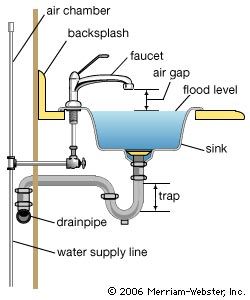

Pipes
Pipes are essential components of the plumbing system, carrying water to and from various fixtures. Different types of pipes are used, depending on the specific application and requirements.
Copper Pipes
Copper pipes are widely used in plumbing systems due to their durability and resistance to corrosion. They are known for their long lifespan and ability to withstand high temperatures and pressures. Copper pipes are commonly used for water supply lines, and their malleability allows for easy installation and shaping.
PVC Pipes
PVC (polyvinyl chloride) pipes are popular in both residential and commercial plumbing systems. They are lightweight, inexpensive, and resistant to chemicals and corrosion. PVC pipes are commonly used for drain, waste, and vent systems, as well as irrigation and water supply lines.
PEX Pipes
PEX (cross-linked polyethylene) pipes have gained popularity in recent years due to their flexibility, durability, and ease of installation. They are suitable for both hot and cold water supply lines and are resistant to freezing and bursting. PEX pipes are commonly used in residential plumbing systems, offering advantages over traditional pipe materials.
Galvanized Steel Pipes
Galvanized steel pipes were commonly used in older plumbing systems. They are coated with zinc to prevent corrosion. However, galvanized pipes are susceptible to rust and scale buildup over time, leading to reduced water flow and potential leaks. Galvanized steel pipes are being phased out in favor of more durable and corrosion-resistant materials.
Fittings
Fittings are essential components that connect and adjust the flow of water within the plumbing system. They ensure proper connections, facilitate directional changes, and allow for adjustments or repairs.
Elbows
Elbows are fittings used to change the direction of the pipe. They come in various degrees, such as 45 degrees and 90 degrees, allowing for flexibility in plumbing layouts. Elbows are commonly used to navigate around corners or obstacles.
Tees
Tees are fittings shaped like the letter “T” and allow for the connection of three pipes at a right angle. They are used in situations where a branch line is required, such as connecting a sink or toilet to the main water line.
Reducers
Reducers are fittings used to connect pipes of different sizes. They ensure a smooth transition between pipes with varying diameters, allowing for efficient water flow. Reducers come in various configurations, including concentric and eccentric designs.
Couplings
Couplings are fittings used to join two pipes together in a straight line. They provide a secure and leak-proof connection, allowing for easy installation and repairs. Couplings are commonly used in situations where a break in the pipe or the addition of a new section is necessary.
Valves
Valves are control devices that regulate or stop the flow of water within the plumbing system. They allow for isolating specific sections, controlling water flow rates, and shutting off the water supply when necessary. Common types of valves include ball valves, gate valves, and globe valves.
In conclusion, understanding the five main components of the plumbing system is essential for maintaining the proper functioning of your home’s water supply and drainage. Each component plays a vital role in ensuring the safe and efficient distribution of water, as well as the removal of wastewater. By familiarizing yourself with these components, you can better troubleshoot any issues that arise and make informed decisions when it comes to plumbing repairs and upgrades. Remember to consult a professional plumber for any complex plumbing problems or installations to ensure the best results.


